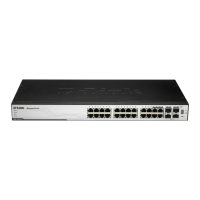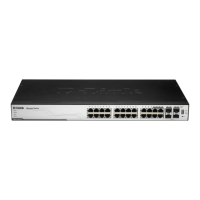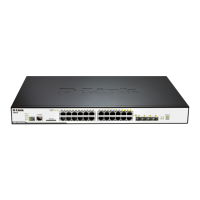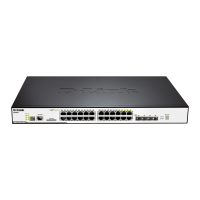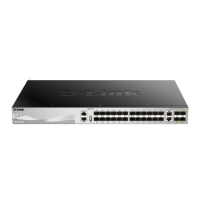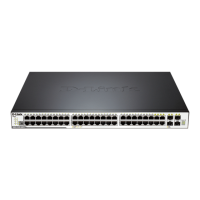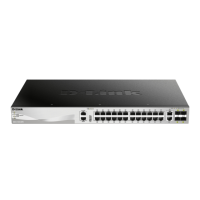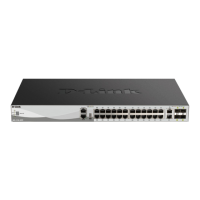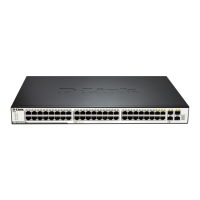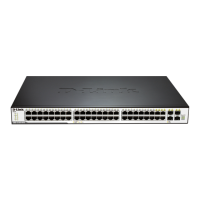Do you have a question about the D-Link DGS-3100-48 and is the answer not in the manual?
Describes the front panel of the DGS-3100 series switch, including port details and console port.
Describes the front panel of the DGS-3100-24TG switch, detailing ports and console port.
Details the use of the web-based interface for switch configuration and monitoring.
Explains SNMP support for network device management and monitoring.
Describes accessing the switch via Command Line Interface using a serial console port.
Provides background for using the Boot/Startup Menu and Embedded Web System.
Covers system information, IP addresses, stacking, and port configuration.
Details Layer 2 features like VLANs, trunks, and spanning tree.
Explains implementing QoS and priority queuing within the network.
Provides information on enabling and configuring device security.
Offers information for monitoring the device's status and performance.
Details configuring the Power over Ethernet (PoE) function.
Provides information for configuring Access Control Lists (ACLs).
Provides a caution regarding the danger of explosion if batteries are replaced incorrectly.
Explains how to download new software versions to update or upgrade system software.
Describes setting the serial bit rate for communication with the management host.
Explains how to activate LED locators to find system devices.
Displays general device information such as system name, location, and versions.
Configures general device information like system name, location, and contact.
Assigns IP addresses, subnet masks, and default gateways to the device.
Enhances network flexibility by building virtual switches with multiple ports.
Configures port properties and LAG properties for Gigabit ports.
Converts IP addresses to physical addresses and maps IP to MAC addresses.
Defines user accounts, passwords, and access rights for device management.
Records and manages events, reports errors, and informational messages.
Assures accurate network device clock time synchronization using SNTP.
Defines system time parameters for local and external SNTP clocks.
Provides methods for managing network devices using SNMP versions 1, 2c, and 3.
Enables DHCP relay and defines DHCP relay servers on the device.
Enables or disables automatic download of image and configuration files from DHCP server.
Manages two software images in flash memory for reboot and backup.
Allows users to enable or disable Telnet service on the device.
Enhances Ethernet networking throughput by enabling larger payloads per packet.
Manages Virtual Local Area Networks (VLANs) for network segmentation and performance.
Assigns a Port VLAN ID (PVID) to ports for packet forwarding decisions.
Describes the default VLAN configuration and port assignments.
Configures global parameters and properties for working with VLANs.
Defines a port as an untagged member in multiple VLANs for specific access.
Distributes VLAN membership information between VLAN-aware bridges.
Assigns ports to Link Aggregation Groups (LAGs) and defines LAG parameters.
Allows frames from unknown VLAN groups to pass through the switch.
Enables administrators to force traffic from source ports to bypass the FDB.
Sets up aggregated links manually or automatically by enabling LACP.
Analyzes incoming packets to determine multicast group participation.
Performs functions for IPv6 multicast routers similar to IGMP Snooping for IPv4.
Enables traffic analysis and monitoring by copying traffic to a designated port.
Provides tree topography to prevent loops and ensure single paths.
Configures settings for both Unicast and Multicast filtering.
Discovers and maintains network topologies by advertising device capabilities.
Explains priority tagging for managing network traffic and application prioritization.
Defines bandwidth settings for a specified interface.
Limits the amount of multicast, broadcast, and unknown unicast frames.
Provides traffic classification by assigning priority values per port.
Assigns priority tags to classes (queues) for traffic handling.
Defines the QoS scheduling forwarding scheme.
Maps DSCP settings to traffic queues for prioritization.
Sets network alarms to protect the CPU from attacks based on threshold levels.
Applies restrictions on managing the device from remote stations.
Limits port access to specific MAC addresses for enhanced network security.
Provides limited network access to authorized ports for guest users.
Authenticates users on a per-port/per-MAC basis via an external server.
Provides additional security for networks using RADIUS servers.
Enables or disables forwarding EAP packets to an authentication server.
Provides a secure communication path using authentication, digital signatures, and encryption.
Allows secure remote login to the network over an insecure network.
Assigns authentication methods for user authentication for different applications.
Defines authentication server information for RADIUS or TACACS+ servers.
Configures the order of methods used to authenticate network users.
Assigns user privileges using authentication methods for device access.
Configures the local enable password for network access.
Validates ARP packets by intercepting, logging, and discarding invalid bindings.
Displays specific information for stacked devices, including unit IDs and versions.
Provides information about the system's CPU utilization.
Contains port utilization information for specific ports.
Displays packets received by the switch, arranged by size.
Contains information about packets transmitted through device ports.
Displays the number of UMB cast packets received on the device.
Contains information about packets transmitted through device ports.
Provides RADIUS authentication session statistics, including initiated and accepted sessions.
Provides information regarding ARP VLANs and IP to MAC address mappings.
Displays which ports are connected to MLD routers.
Displays which ports are connected to routers.
Displays information regarding device sessions initiated by system users.
Contains vital IGMP group information, including multicast group IP and MAC addresses.
Contains vital MLD group information, including multicast group IP and MAC addresses.
Manages MAC addresses, including learning and static configuration.
Displays system log entries for device events, operations, and information.
Provides power saving technology by reducing consumption on short cables or link down.
Displays basic information regarding the device's operating environment.
Contains system PoE information for enabling PoE, monitoring power usage, and enabling PoE traps.
Displays and allows editing of system PoE information, including power thresholds.
Provides information for configuring Access Control Lists intuitively.
Manually configures ACL profiles, which define how packets are forwarded based on ACL criteria.
Defines conditions for access rules, including source/destination IP, protocol, DSCP, and action.
Identifies rules assigned to a specific port to find ACL rules.
Defines time periods for Access Control Lists to be applied to ACL rules.
Illustrates the pin allocation for the RJ-45 Ethernet ports.
Details the pin allocation of the RJ-45 connectors.
Illustrates the pin allocation for the HDMI connector used for stacking.
Details the pin allocation of the HDMI connector.
Describes the front panel of the DGS-3100 series switch, including port details and console port.
Describes the front panel of the DGS-3100-24TG switch, detailing ports and console port.
Details the use of the web-based interface for switch configuration and monitoring.
Explains SNMP support for network device management and monitoring.
Describes accessing the switch via Command Line Interface using a serial console port.
Provides background for using the Boot/Startup Menu and Embedded Web System.
Covers system information, IP addresses, stacking, and port configuration.
Details Layer 2 features like VLANs, trunks, and spanning tree.
Explains implementing QoS and priority queuing within the network.
Provides information on enabling and configuring device security.
Offers information for monitoring the device's status and performance.
Details configuring the Power over Ethernet (PoE) function.
Provides information for configuring Access Control Lists (ACLs).
Provides a caution regarding the danger of explosion if batteries are replaced incorrectly.
Explains how to download new software versions to update or upgrade system software.
Describes setting the serial bit rate for communication with the management host.
Explains how to activate LED locators to find system devices.
Displays general device information such as system name, location, and versions.
Configures general device information like system name, location, and contact.
Assigns IP addresses, subnet masks, and default gateways to the device.
Enhances network flexibility by building virtual switches with multiple ports.
Configures port properties and LAG properties for Gigabit ports.
Converts IP addresses to physical addresses and maps IP to MAC addresses.
Defines user accounts, passwords, and access rights for device management.
Records and manages events, reports errors, and informational messages.
Assures accurate network device clock time synchronization using SNTP.
Defines system time parameters for local and external SNTP clocks.
Provides methods for managing network devices using SNMP versions 1, 2c, and 3.
Enables DHCP relay and defines DHCP relay servers on the device.
Enables or disables automatic download of image and configuration files from DHCP server.
Manages two software images in flash memory for reboot and backup.
Allows users to enable or disable Telnet service on the device.
Enhances Ethernet networking throughput by enabling larger payloads per packet.
Manages Virtual Local Area Networks (VLANs) for network segmentation and performance.
Assigns a Port VLAN ID (PVID) to ports for packet forwarding decisions.
Describes the default VLAN configuration and port assignments.
Configures global parameters and properties for working with VLANs.
Defines a port as an untagged member in multiple VLANs for specific access.
Distributes VLAN membership information between VLAN-aware bridges.
Assigns ports to Link Aggregation Groups (LAGs) and defines LAG parameters.
Allows frames from unknown VLAN groups to pass through the switch.
Enables administrators to force traffic from source ports to bypass the FDB.
Sets up aggregated links manually or automatically by enabling LACP.
Analyzes incoming packets to determine multicast group participation.
Performs functions for IPv6 multicast routers similar to IGMP Snooping for IPv4.
Enables traffic analysis and monitoring by copying traffic to a designated port.
Provides tree topography to prevent loops and ensure single paths.
Configures settings for both Unicast and Multicast filtering.
Discovers and maintains network topologies by advertising device capabilities.
Explains priority tagging for managing network traffic and application prioritization.
Defines bandwidth settings for a specified interface.
Limits the amount of multicast, broadcast, and unknown unicast frames.
Provides traffic classification by assigning priority values per port.
Assigns priority tags to classes (queues) for traffic handling.
Defines the QoS scheduling forwarding scheme.
Maps DSCP settings to traffic queues for prioritization.
Sets network alarms to protect the CPU from attacks based on threshold levels.
Applies restrictions on managing the device from remote stations.
Limits port access to specific MAC addresses for enhanced network security.
Provides limited network access to authorized ports for guest users.
Authenticates users on a per-port/per-MAC basis via an external server.
Provides additional security for networks using RADIUS servers.
Enables or disables forwarding EAP packets to an authentication server.
Provides a secure communication path using authentication, digital signatures, and encryption.
Allows secure remote login to the network over an insecure network.
Assigns authentication methods for user authentication for different applications.
Defines authentication server information for RADIUS or TACACS+ servers.
Configures the order of methods used to authenticate network users.
Assigns user privileges using authentication methods for device access.
Configures the local enable password for network access.
Validates ARP packets by intercepting, logging, and discarding invalid bindings.
Displays specific information for stacked devices, including unit IDs and versions.
Provides information about the system's CPU utilization.
Contains port utilization information for specific ports.
Displays packets received by the switch, arranged by size.
Contains information about packets transmitted through device ports.
Displays the number of UMB cast packets received on the device.
Contains information about packets transmitted through device ports.
Provides RADIUS authentication session statistics, including initiated and accepted sessions.
Provides information regarding ARP VLANs and IP to MAC address mappings.
Displays which ports are connected to MLD routers.
Displays which ports are connected to routers.
Displays information regarding device sessions initiated by system users.
Contains vital IGMP group information, including multicast group IP and MAC addresses.
Contains vital MLD group information, including multicast group IP and MAC addresses.
Manages MAC addresses, including learning and static configuration.
Displays system log entries for device events, operations, and information.
Provides power saving technology by reducing consumption on short cables or link down.
Displays basic information regarding the device's operating environment.
Contains system PoE information for enabling PoE, monitoring power usage, and enabling PoE traps.
Displays and allows editing of system PoE information, including power thresholds.
Provides information for configuring Access Control Lists intuitively.
Manually configures ACL profiles, which define how packets are forwarded based on ACL criteria.
Defines conditions for access rules, including source/destination IP, protocol, DSCP, and action.
Identifies rules assigned to a specific port to find ACL rules.
Defines time periods for Access Control Lists to be applied to ACL rules.
Illustrates the pin allocation for the RJ-45 Ethernet ports.
Details the pin allocation of the RJ-45 connectors.
Illustrates the pin allocation for the HDMI connector used for stacking.
Details the pin allocation of the HDMI connector.
| Switch Type | Managed |
|---|---|
| Number of Ports | 48 |
| Port Speed | 10/100/1000 Mbps |
| Ports | 48 x 10/100/1000 Mbps |
| Layer | Layer 2 |
| Power over Ethernet (PoE) | No |
| Switching Capacity | 104 Gbps |
| Forwarding Rate | 77.4 Mpps |
| Flash Memory | 32 MB |
| Jumbo Frame Support | Yes |
| Power Supply | Internal |
| Input Voltage | 100-240V AC |
| Uplink Ports | 4 x SFP |
| Jumbo Frame Size | 9216 bytes |
| Dimensions | 440 x 44 mm |
